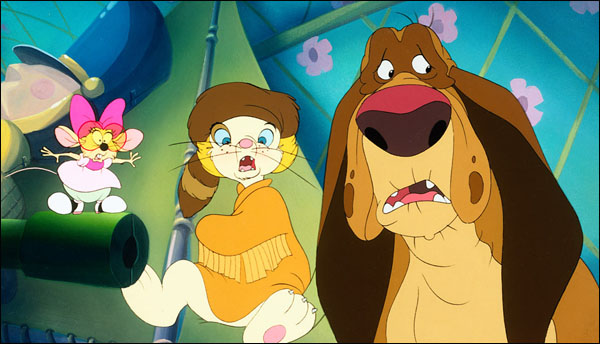
Suspended Animation #334
Rock-A-Doodle (1991) was a confused animated feature produced by Sullivan Bluth Studios and Goldcrest Films.
Disney had spent some time unsuccessfully trying to develop an animated feature based on the classic Chanticleer tale of the rooster who believed his morning crowing brought up the sun each day but eventually abandoned the project because of story problems.
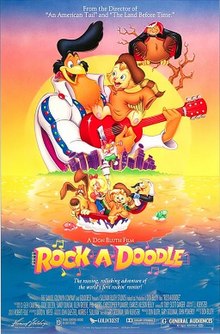 As early as 1982 on a foreign publicity tour for The Secret of NIMH, Bluth announced that the story of Chanticleer would be one of his upcoming films.
As early as 1982 on a foreign publicity tour for The Secret of NIMH, Bluth announced that the story of Chanticleer would be one of his upcoming films.
The Bluth version takes place in 1959 with the rooster meant to reference Elvis Presley. Glen Campbell who had been a friend of Elvis and had done an Elvis impersonation in his concerts before Elvis died voiced the rooster.
Don Bluth was fascinated with Who Framed Roger Rabbit (1988) and wanted to emulate it with Rock A Doodle by having a live action-animation hybrid. There was a lot of live action footage shot for the film to serve as a live action bracket to the animation. It was originally filmed in black-and-white and then once it went to animation it would be in full color in the manner of the 1939 MGM film The Wizard of Oz.
The film opened on Edmond’s farm with his mother (played by an Irish actress but later dubbed by Dee Wallace Stone) reading her son the story of Chanticleer. There was no narration by Phil Harris. Bluth himself did the direction.
Bluth and Gary Goldman wanted to have their own version of a Jessica Rabbit character. That was the reason for the Goldie the Pheasant character. Originally she was more endowed with larger breasts, cleavage and a skimpy dress with lots of glitter. This version can be seen in the early trailer for the film on the All Dogs Go To Heaven (1989) video tape.
The studio test-screened the film shortly before that video was released. They found that mothers were offended by Goldie’s outrageous proportions. Goldcrest didn’t want the film to be rated PG since it would limit a potential audience. Bluth’s America studio covered up those exaggerated proportions with feathers using cel overlays.
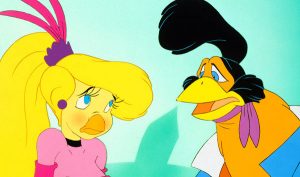 In the “Kiss and Coo” scene, animator Bob Miller redrew the King’s wine glass into a transparent cup and the wine bottle to be King soda. Goldcrest felt that having the rooster be an alcoholic was not a good idea.
In the “Kiss and Coo” scene, animator Bob Miller redrew the King’s wine glass into a transparent cup and the wine bottle to be King soda. Goldcrest felt that having the rooster be an alcoholic was not a good idea.
The film originally included darker elements, a famous one being a deleted sequence from the kitchen scene. In this sequence the Duke bakes a live baby skunk in a pie and then eats it. Oddly enough, according to Gary Goldman, the reason this was cut wasn’t because of the content but because Bluth’s studio received a complaint from Goldcrest’s marketing representative that most cases of child abuse happen in the kitchen, and involve baking instruments.
Test screenings showed that audiences were confused by the story so a basset dog narrator (voiced by Phil Harris in his last performance before his retirement) was added. Co-director Gary Goldman recalled in August 2002 that “Phil Harris was great. It wasn’t hard to sign him up. He had done such a good job on Disney’s Jungle Book (1967) we just thought he was a great choice for the dog, Patou, in Rock-A-Doodle. He loved to work and had a good time doing this voice-over. He was well into his 70’s when he did the role.”
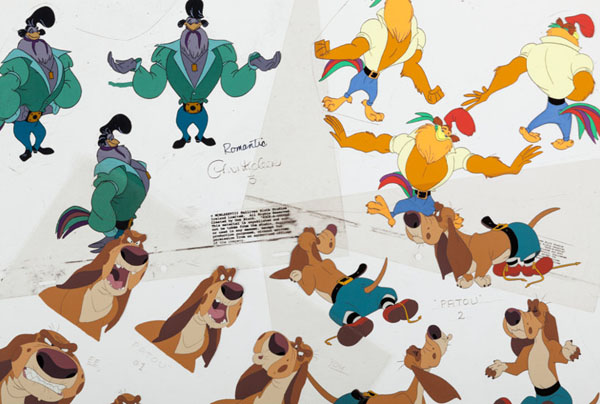
A notice in the June 1990 issue of the studio newsletter stated the cuts were “to create appeal to the broadest spectrum of audience.”
The article went on to state “The repairs involve some rerecording and an additional contribution by Phil Harris, the voice of Patou. We have restructured the continuity which allows the audience to stay focused on Edmund and the adventure he’s undertaking. Chanticleer’s role as ‘The King’ works very well now without confusing the audience as to who is the hero (adults seem to be attracted to Chanticleer and children to Edmund). Small snippets were made here and there which have polished the continuity and everyone feels the film has been greatly enhanced.”
The Samuel Goldwyn Company teamed up with Macy’s in 1991 to produce a Rock-a-Doodle float to promote the release of the film the following April. The float featured an old, rickety treehouse, recycled from a Cabbage Patch Kids float that had previously appeared in the parade, and was adorned with many of the film’s characters, dancing and waving as they head down the Parade route. The float made its only appearance in Thanksgiving 1991 and was not seen in the following years.
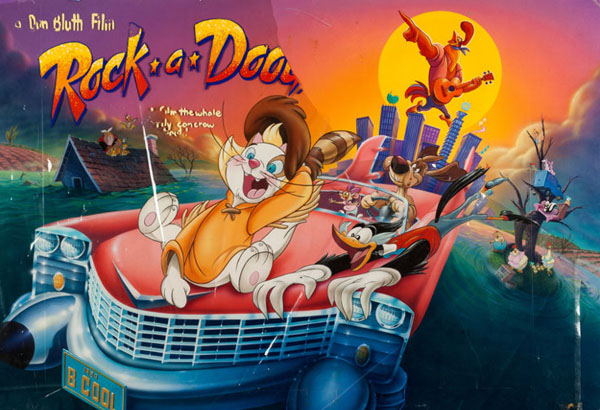
In 1992, Bluth told reporters: “I first found the story of Chanticleer when I was reading the works of 19th Century playwright Edmond Rostand who also wrote Cyrano de Bergerac. Here was a story about a man who had lost faith in himself and starts to believe his whole life is a sham. I don’t cry easily but I was moved.
“Then I started thinking about Man of La Mancha, a broken down old man who sees what he wants to see so he becomes a great knight and windmills become giants.
 “All of this was more complicated than we could give to an audience of four year olds so we twisted it around and tried to tell it to children: if you lose your self confidence, you can’t do a thing. But if you have it, you can do anything. And we told it in a silly cartoon kind of way.
“All of this was more complicated than we could give to an audience of four year olds so we twisted it around and tried to tell it to children: if you lose your self confidence, you can’t do a thing. But if you have it, you can do anything. And we told it in a silly cartoon kind of way.
“Singer Glen Campbell is the voice of the rooster and most people don’t know he was a session guitarist on some Elvis records. He went in and did the initial thrust of the character. Then we animated a little bit of it and we said, “Wait a minute, that’s turning out differently than we thought” so we called him back.
“Originally he wasn’t going to mimic Elvis. In fact, we were very shy about asking him to do that. But once he heard the music he started laughing and we didn’t know how he was going to take this. But he stepped to the microphone. He suddenly did Elvis. I think he did it just because it was a hoot for him.
“And then he said, “The Jordanaires (Presley’s sometime backup group) are in town. Let’s bring ‘em in and have them sing backup. So we did.”

In 2002, Bluth added, “The film did not turn out as we planned. Our first problem occurred at the start of the production of the live-action bookend elements, where the story gets set up and resolved. Victor French was hired to direct the live action. Just after he arrived to start the shoot, he discovered that he had pancreatic cancer. Eight weeks later, he was gone. What a disaster for him and for our film.
“[But] the next disaster was that Goldcrest became concerned about one of our funniest sequences in the film. It was the sequence where Christopher Plummer’s character, the Grand Duke (the large Great Horned Owl), was in his kitchen, making a skunk pie.
“The skunk was a baby skunk, with the voice of an eight-year old actor. Goldcrest made us cut most of this sequence out even though the baby skunk escapes. This sequence was one of the favorite sequences of the children of the staff. This was a great disappointment as it got some of the biggest laughs in the film. We really felt that the film was being gutted.”


 Jim Korkis is an internationally respected animation historian who in recent years has devoted his attention to the many worlds of Disney. He was a columnist for a variety of animation magazines. With his former writing partner, John Cawley, he authored several animation related books including The Encyclopedia of Cartoon Superstars, How to Create Animation, Cartoon Confidential and Get Animated’s Animation Art Buyer’s Guide. He taught animation classes at the Disney Institute in Florida as well as instructing classes on acting and animation history for Disney Feature Animation: Florida.
Jim Korkis is an internationally respected animation historian who in recent years has devoted his attention to the many worlds of Disney. He was a columnist for a variety of animation magazines. With his former writing partner, John Cawley, he authored several animation related books including The Encyclopedia of Cartoon Superstars, How to Create Animation, Cartoon Confidential and Get Animated’s Animation Art Buyer’s Guide. He taught animation classes at the Disney Institute in Florida as well as instructing classes on acting and animation history for Disney Feature Animation: Florida.




















































I never saw “Rock-a-Doodle”. I was dating a Jewish girl at the time, and the release of “An American Tail 2: Fievel Goes West” the previous December reignited her outrage at Bluth and Spielberg for having promoted the original movie by marketing Fievel Mousekowitz Christmas decorations. Pointing out that every single Christmas nativity scene in the world has a Jewish kid in it failed to mollify her. There was no way she was going to see any Don Bluth movie, and seeing a kids’ movie by myself, as a 30-year-old man, was not an option.
Many of Bluth’s films have serious story problems that should have been solved in the planning stages, and “Rock-a-Doodle” seems to have suffered from this as well. The heavy-handed interference from Goldcrest no doubt made matters much worse. Film distributors should stick to distributing and not try to control every aspect of the content, especially when the result is a box office disaster that sends the studio into bankruptcy. Talk about biting the hand that feeds you.
Bluth was mistaken: Victor French died of lung cancer, in 1989. It was his friend and co-star on “Highway to Heaven”, Michael Landon, who died of pancreatic cancer, two years later. Both men were only 54.
If they wanted to fix the movie,
They should have started with Edmund,
Without which it might have been tolerable
And much more well respected.
His voice is so annoying,
And his presence in every scene,
Makes me also question
What this film otherwise might have been.
Indeed. The kid had trouble pronouncing Chanticleer….and he says it a LOT.
Well, remember, like other Bluth films (indeed, DIsney, as well!) young characters, he was voiced by a kid (who appears in the live section).
By the way, anyone seen The Nostalgia Critic’s review, from his early days, on the movie? Hilarious as hell..comments,for example, on three narrators being in the film!)SJC
Honestly, I find Doug Walker OVERRATED. Plus, I feel like his “All Dog Go to Heaver” “review” sort of loosely plagiarized Jerry’s own natural review in the “Animated Movies” book.
I like most of Don Bluth’s Stuff, although I admit The Pebble and the Penguin and Thumbelina were a bit of slog to get through.
I was hoping Titan A.E. would have been a bit of a comeback for him. People are always complaining they want more mature/grown up animation without the toilet humor – here was one and I guess it tanked at the box office. Oh well, guess its easy to be an armchair critic.
Titan AE was before the glut of cheap joke films though; at the time we’d only just started to see that family friendly animated films (which Titan AE is, for all its mild edge) could be major commercial success in the US without the Disney name, but seemingly only if it were based on an already popular brand (Rugrats, Pokemon) or were something that could almost be mistaken for a Disney (Prince of Egypt, Anastasia) or Pixar (Antz) film. By then Bluth’s 80s hits seemed like an anomaly. Maybe if it had come after the CG animated boom it would have seemed more refreshing and performed better, but then again, probably not, similar later attempts like 9 and Battle for Terra did even worse.
I loved The Secret of NIMH and, as a kid in the early-80’s, Dragon’s Lair and Space Ace were huge. Sadly, most of his other films simply didn’t work for me. They looked great, in many cases, but the stories always had major problems. I adored Anastasia and really hoped that it would be the start of more great work from Bluth. Unfortunately, it underperformed and Titan AE was the nail in the coffin.
I thought the two produced by Spielberg were well-done (it also helps that two late great Sesame Street writers wrote the screenplay).
I was a kid then and I’m an adult now almost in my 40s. But sometimes, when nobody’s looking, when I throw my shoes on for the day, I still say out loud “Over, Under, around and through. That’s how Patou ties his shoe.”
“Rock-A-Doodle (1991) was a confused animated feature” That’s an understatement. I know people that still has no idea what the heck was that, the baffled look after seeing just some minutes of that was amazing.
In the other hand it still has some good stuff going on in it. You have to admit those last weird Bluth movies are anything but boring, if nothing else.
Rock-a-Doodle is the only bad Don Bluth movie I would mostly blame Don for. Yes, I understand why his focus might have been compromised at the time, and yes, censors suck, but the badness is mostly him. Sadly, this 1 failure did not allow him to recover, and 3 bad movies in a row after this one.
WHAT IS THE BLASPHEMY IS YOU GUYS TALKING ABOUT. THIS IS AND WILL ALWAY’S BE THE BEST MOVIE CARTOON EVER MADE. I AM THAT ROOSTER!
y’all trippin!
Rock A Doodle is GOLD!
I had no idea how much of an influence Don Bluth had on my life until I had a memory about Rock-a-doodle, and then looked up his filmography. Everything he directed were literally my childhood. Anastasia, Fox and the Hound, Titan AE, A Troll in Central Park, All Dogs go to Heaven, a pebble and a penguin… wild. they def have their issues. but honestly better than the Disney films I also grew up on.